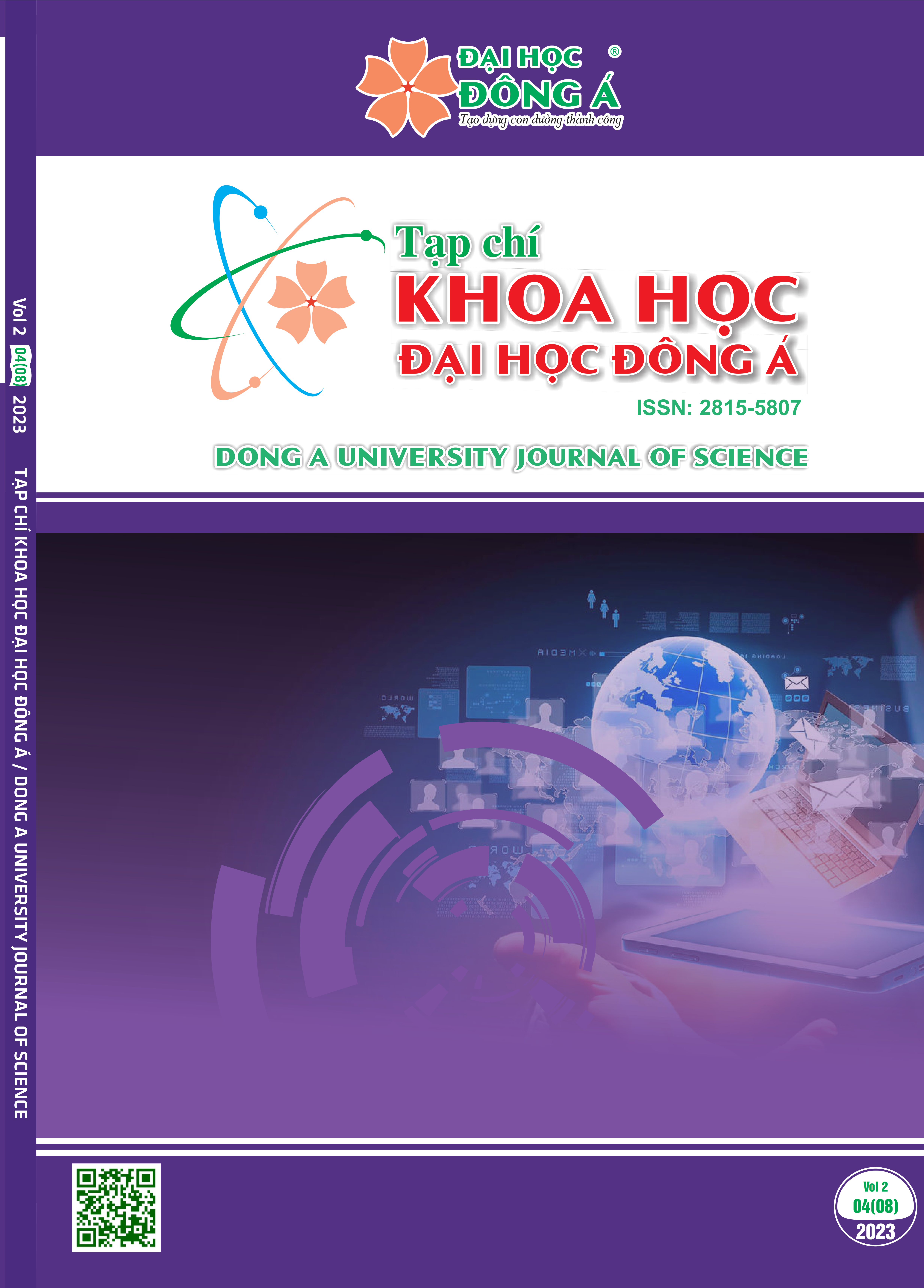Tác động của truyền miệng điện tử (eWOM) đến ý định mua hàng trực tuyến của thế hệ Z tại Đà Nẵng
Nội dung chính của bài viết
Tóm tắt
Mục đích của nghiên cứu nhằm xác định ảnh hưởng của truyền miệng điện tử (eWOM) đến ý định mua hàng trực tuyến của thế hệ Z tại Đà Nẵng. Dữ liệu được thu thập bằng hình thức khảo sát trực tuyến và trực tiếp với ba đối tượng chính là người đi làm, sinh viên và học sinh. Với 350 quan sát hợp lệ đã được sử dụng để kiểm định các mối quan hệ thông qua mô hình cấu trúc (SEM). Kết quả của bài nghiên cứu cho thấy các giả thuyết đều được chấp nhận, có ý nghĩa về mặt thống kê, góp phần chứng minh, mở rộng các giả thuyết trước đây và phù hợp với tình hình thực tế. Cụ thể, chất lượng eWOM, sự tin cậy eWOM, kiến thức trải nghiệm và sự quan tâm của người tiêu dùng là các yếu tố chính tác động đến sự chấp nhận eWOM. Từ đó, sự chấp nhận eWOM có ảnh hưởng đến ý định mua hàng trực tuyến thông qua thái độ đối với hành vi, chuẩn mực chủ quan và nhận thức kiểm soát hành vi. Nghiên cứu đã đề xuất một số giải pháp ứng dụng trong thực tiễn nhằm giúp các doanh nghiệp nâng cao ý định mua hàng trực tuyến của thế hệ Z. Hơn nữa, đề xuất ứng dụng khởi nghiệp Evisi Young và mở ra hướng nghiên cứu trong tương lai.
Chi tiết bài viết
Từ khóa
Truyền miệng điện tử, ý định mua hàng trực tuyến, thế hệ Z, eWOM, sự chấp nhận eWOM
Tài liệu tham khảo
Trần Thanh Tú, (2022), “Tác động của truyền miệng điện tử đến ý định mua hàng trực tuyến tại Thành phố Hồ chí Minh”, Tạp chí khoa học kinh tế, số 10 (2), tr. 64-82.
Lam, A. Y. C., Lau, M. M., Cheng, C., Wong, M. Y., (2019), “The impact of electronic word-of-mouth on young consumers' purchase intention in Hong Kong”, IC4E'19: Proceedings of the 10th International Conference on E-Education, E-Business, E-Management and E-Learning, pp. 329–333.
Ajzen, I., (1991), The theory of planned behavior, Organizational behavior and human decision.
Bansal, H. S., & Voyer, P. A., (2000), “Word-of-mouth process within a service purchase decision context”, Journal of Service Research, 3 (2), pp. 166-177.
Chatterjee, P., (2001), “Online Reviews: Do Consumers Use Them?”, Advances in Consumer Research, 28 (1), pp. 129–134.
Cheung, M., Luo, C., Sia, C., & Chen, H., (2009), “Credibility of electronic word-of-mouth: Informational and normative determinants of on-line consumer recommendations”, International Journal of Electronic Commerce, 13 (4), pp. 9-38.
Chevalier, J. A., & Mayzlin, D., (2006), “The Effect of Word of Mouth on Sales: Online Book Reviews”, Journal of Marketing Research, 43 (3), pp. 345-354.
DeLone, W., & McLean, E. R., (2003), “The DeLone and McLean model of information systems success: A ten-year update”, Journal of Management Information Systems, 19 (4), pp. 9–30.
Fan, Y. W, Miao, Y .F, Fang, Y. H & Lin, R. Y., (2013), “Establishing the Adoption of Electronic Word-of-Mouth through Consumers’ Perceived Credibility”, International Business Research, 6 (3), pp. 58-65.
Gilly, M. C., Graham, J. L., Wolfinbarger, M. F., & Yale, L. J., (1998), “A dyadic study of interpersonal information search”, Journal of Academic Marketing Science, 26 (2), pp. 83-100.
Hansen, T., Jensen, J. M., & Solgaard, H. S., (2004), “Predicting online grocery buying intention: a comparison of the theory of reasoned action and the theory of planned behavior”, International Journal of Information Management, 24(6), pp. 539-550.
Hennig-Thurau, T., Gwinner, K. P., Walsh, G., & Gremler, D. D., (2004), “Electronic word-of mouth via consumer-opinion platforms: What motivates consumers to articulate themselves on the internet?”, Journal of Interactive Marketing, 18 (1), 38-52.
Laroche, M., Kim, C., Zhou, L., (1996), “Brand Familiarity and Confidence as Determinants of Purchase Intention: An Empirical Test in a Multiple Brand Context”, Journal of Business Research, 37 (2), pp. 115-120.
Mohammad, R. J. & Neda S., (2012), “The effect of electronic word of mouth on brand image and purchase intention”, Marketing Intelligence & Planning, 30 (4), pp. 460-476.
Palka, W., Pousttchi, K., & Wiedemann, D. G. (2009), “Mobile word-of-mouth-A grounded theory of mobile viral marketing”, Journal of Information Technology, 24 (2), pp. 172-185.
Park, D. H., & Lee, J., (2008), “eWOM overload and its effect on customer behavioral intention depending on customer involvement”, Electronic Commerce Research and Applications, 7 (4), 386-398.
Park, D. H., Lee, J., & Han, I., (2007), “The effect of on-line consumer reviews on consumer purchasing intention: The moderating role of involvement”, International journal of electronic commerce, 11 (4), pp. 125-148.
Pavlou, P. A., & Fygenson, M., (2006), “Understanding and predicting electronic commerce adoption: An extension of the theory of planned behavior”, MIS quarterly, pp. 115-143.
Petty, R. E., & Cacioppo, J. T., (1984), “The effects of involvement on response to argument quantity and quality: Central and peripheral routes to persuasion”, Journal of Personality and Social Psychology, 46 (1), pp. 69-81.
Salisbury, W. D., Pearson, R. A., Pearson, A. W. & Miller, D. W. (2001), “Perceived security and World Wide Web purchase intention”, Industrial Management & Data Systems, 101 (4), pp. 165-177.
Shu, M., & Scott, N., (2014), “Influence of social media on Chinese students’ choice of an overseas study destination: An information adoption model perspective” Journal of Travel and Tourism Marketing, 31 (2), pp. 286-302.
Sussman, S. W., & Siegal, W. S., (2003), “Informational influence in organizations: An integrated approach to knowledge adoption”, Information systems research, 14 (1), pp. 47-65.


